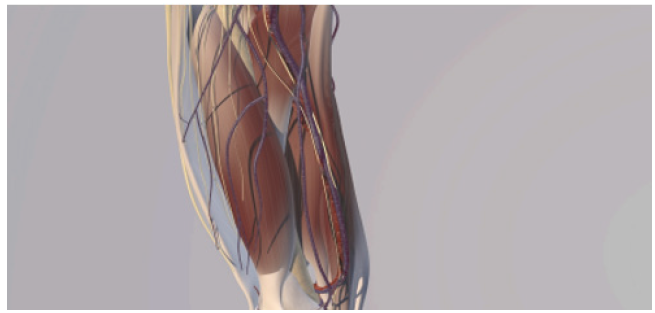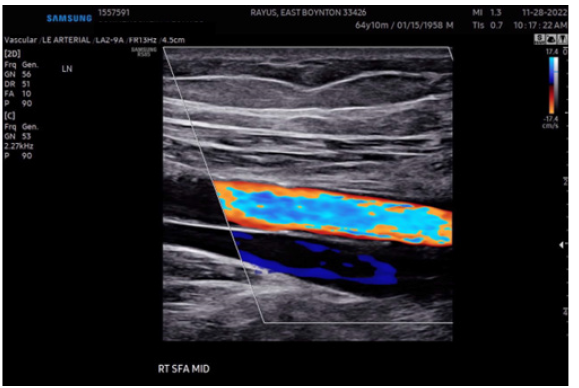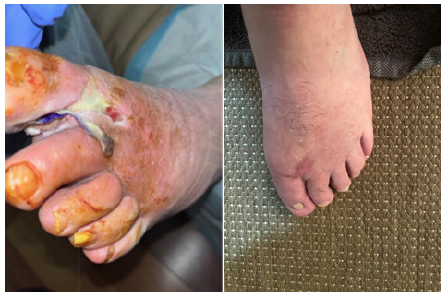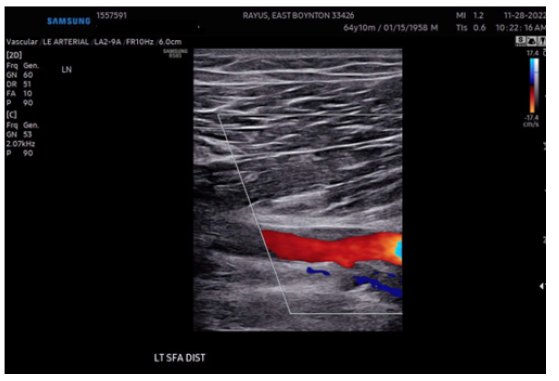Research Article 
 Creative Commons, CC-BY
Creative Commons, CC-BY
Phytotherapy Management in a Vaccinated Diabetic Patient with Foot Ulceration and Peripheral Vascular Disease: A Case Study of a Dietary Supplement and Its Effect on Arterial Blood Flow
*Corresponding author:Leonard Sonnenschein, The Sonnenschein Institute, USA.
Received:May 01, 2023; Published:May 09, 2023
DOI: 10.34297/AJBSR.2023.18.002516
Abstract
A 64-year old male with diabetes treated with COVID-19 Vaccine developed a diabetic ulcer and significant blood clotting in left leg altering arterial blood flow to monophasic. Dietary supplement “All Clear” was used for 7 days, one capsule at each meal. The treatment consisted in providing the plant based “All Clear” supplement of a proprietary blend of 15 Digestive Enzymes. The average IU per capsule is 2000 IU and consists of: Catalase 1000 IU per capsule, Wasabia japonica 15mg, Amoracia rusticana 85mg, and brown rice. One capsule of “All Clear” was taken with large meals, no more than three times a day. After the initial Doppler study (11/28/2022), “All Clear” formulation was used 1 capsule per meal for 7 days and a repeat bilateral lower extremity dopplers were performed with grayscale, color doppler and spectral analysis of the common femoral, superficial femoral, popliteal artery, posterior tibial and dorsalis pedis arteries with peak systolic velocity and waveform re-evaluation was done on 12/5/22 showing improvement in blood flow of the right dorsalis pedis artery which normalized to triphasic blood flow from a monophasic pattern and the right posterior tibial artery also normalized to triphasic blood flow from a biphasic pattern with significant left leg recovery as well. After one week, the patient reported that his legs felt much better. The left leg was no longer edematous and red coloration of left foot had dissipated. It can be concluded that this supplement (“All Clear”) can help restore/increase arterial blood flow by reducing the blood clots.
Keywords: Arterial Blood Clots, Enzymes, COVID-19 Vaccine, Arterial Doppler Study, Monophasic, Triphasic, Peripheral Vascular Disease, Increasing Arterial Blood Flow, Diabetes Wound
Introduction
Vascular endothelial cells cover the interior surface of blood vessels, constituting a highly complex and dynamic entity—the endothelium—which has a remarkable heterogeneity. Peripheral edema in the lower limb plays an underestimated part in prolonged wound healing. Injudicious use of over-medicalized clinical treatment, and surgical procedures, carries the risk of tissue necrosis due to underlying peripheral vascular disease. The purpose of this case study is to evaluate the effectiveness of a proprietary dietary supplement in increasing blood flow. Applying rigid guidelines may exclude eligible patients who may benefit from alternative therapies. Albeit without losing its vessel properties as an integrated system we perform alternative phytotherapy, consisting of 1–3 active principles: The supplement consists of a proprietary blend of 15 Enzymes. The capsule consists of: Catalase 1000 IU per capsule, Wasabia japonica 15mg, Amoracia rusticana 85mg, and brown rice. One capsule is to be taken with large meals, no more than three times a day. This new formula performs a metabolically active role by exchanging nutrients and other elements between the blood and the tissue layer, as well as by regulating different physiological processes such as inflammation, vessel regulation, angiogenesis, and hemostasis.
Composition of the Supplement
Catalase is one of the crucial antioxidant enzymes that mitigate oxidative stress to a considerable extent by destroying cellular hydrogen peroxide to produce water and oxygen. Deficiency or malfunction of catalase is postulated to be related to the pathogenesis of many age-associated degenerative diseases like diabetes mellitus, hypertension, anemia, vitiligo, Alzheimer’s disease, Parkinson’s disease, bipolar disorder, cancer, and schizophrenia [1]. Wasabia japonica has anti-inflammatory, anti-microbial, anti-cancer and anti-platelet effects. Water grown variety, which is known as Sawa, produces the best Wasabia japonica plants with the highest level of bioactive components. The 6-MITC of Sawa Wasabi has been found to inhibit platelet aggregation a property useful in the elderly, where preventing excessive clotting is vital [2,3].
Horseradish, Amoracia rusticana, - a strong spice which has been successfully applied in phytotherapy for its valuable effects on health [4]. Although used for a long time in traditional medicine, its therapeutic properties had not been documented until recently, confirming in part the utilization of this vegetal product in indigenous medicine of different nations [5]. The volatile oil, by its components transmits its revulsive, diuretic and antiseptic properties. Horseradish consumption normalizes the arterial pressure and prevents the risk of blood clots formation. Simultaneously, sulfurous substances from horseradish enhance the elasticity of cerebral and coronary blood vessels, thus reducing the risk of an infarct or cerebrovascular accident [4].
Measurements
The doppler waveform of the lower extremity arteries at rest is classified as high pulsatility waveform and is characterized by a triphasic flow pattern. Over the course of each heartbeat, a tall, narrow, and sharp systolic peak in the first phase is followed by early diastolic flow reversal in the second phase and then by late diastolic forward flow in the third phase. Diastolic flow reversal results from the high peripheral resistance of normal extremity arteries. In normal extremity arteries flow acceleration in systole is rapid, which means that the peak velocity is reached within a few hundredths of a second after ventricular contraction begins. Blood in the center of the artery moves faster than blood at the periphery, which is described as laminar flow. If the waveform is monophasic, that means that the entire waveform is either above or below the Doppler spectrum baseline, depending on the orientation of the US transducer [6]. It is characterized by a “damped” pattern, which means that systolic flow acceleration is slowed, peak systolic velocity is reduced, and diastolic flow is increased [7]. This monophasic waveform is seen at the stenotic site and in the distal artery in cases of severe stenosis with a diameter reduction of more than 50% [8]. The biphasic waveform is also considered normal as it contains both forward and reverse flow
Materials and Methods
This case study consisted of Mr. X a 64-year-old male, 230 pounds, diet controlled diabetic, non- smoker, non-drinker who was admitted to the hospital in August 2022 for a left foot infection. After he healed from this infection, from 11/28/2022 through 12/5/2022 he took the “All Clear” supplement, 1 capsule with meals x 7 days in attempt to increase arterial blood flow and to perhaps prevent recurrence of this foot ulcer/infection. (Figure 1) shows the infected left Foot Ulcer in August 2022 and April 2023.
Other possible pertinent medical background of this patient is that approximately in February 2022 he started experiencing tingling pain in arms and legs, heart arrhythmia, and foot numbness. He received the Johnson and Johnson Covid-19 vaccine in November 2021. Also, in July 2022 during consumption of a pastrami sandwich, he accidentally bit his tongue in half, exposing large blood vessels and subsequent large string-like strands emanated from the opened blood vessels...presumed clots.
Patient Background
The patient had originally been presented to Delray Medical Center, Delray Beach, Florida USA in August 2022 with an active ulcer of his left foot, unilaterally, for which the original cause was underlying peripheral vascular disease. Upon hospital admission HbA1c was 7.5 and fasting blood glucose 361 mg/dl. Despite antibiotic therapy and regular dressings, the ulcer became infected and required treatment at the Hospital. Mr. X’s previous medical history included being a diet-controlled diabetic, non-smoker, nondrinker, tingling pain in arms, and legs-bilateral, heart arrhythmia, without myocardial infarction, and foot numbness. The presence of edema in his legs had caused Mr. X difficulty walking. His diabetes was well controlled using diet alone over 20+ years with previous peak fasting blood glucose levels less than 150 mg/dl and Hb A1c levels below 5.5%. Only daily medication being Lisinopril 20 mg per day. By mid-November 2022, HbA1c was 6.1 with fasting blood glucose 88 mg/dl with left foot ulcer healed. However, my left leg and foot were still swollen with foot reddened compared to right foot and leg.
Provided Treatment
The 7-Day treatment consisted of providing the “All Clear” supplement of a proprietary blend of 15 Digestive Enzymes. The average IU per capsule is 2000 IU and consists of: Catalase 1000 IU per capsule, Wasabia japonica 15mg, Amoracia rusticana 85mg, and brown rice. One capsule of “All Clear” was to be taken with large meals, no more than three times a day.
Doppler Study Results
On 11/28/22 spectral and color doppler evaluation of the bilateral lower extremity arterial system (Figure 2) was performed. Positive findings consisted of monophasic flow in the bilateral dorsalis pedis arteries which may reflect moderate peripheral vascular disease.

Figure 2:Anatomy Image: The vastus lateralis/medialis and sartorius muscles have been removed in order to visualize the femoral vasculature. Permission given by probeultrasound.com to use this image.
Repeat Arterial Doppler Study Results on 12/5/2022
After this initial Doppler study, “All Clear” formulation was used 1 capsule per meal for 7 days and a repeat bilateral lower extremity dopplers were performed with grayscale, color doppler and spectral analysis of the common femoral, superficial femoral, popliteal artery, posterior tibial and dorsalis pedis arteries with peak systolic velocity and waveform evaluation was done on 12/5/22 showing improvement in blood flow of the right dorsalis pedis artery which normalized to triphasic blood flow from a monophasic pattern and the right posterior tibial artery also normalized to triphasic blood flow from a biphasic pattern. The Study reveals triphasic blood flow found throughout the right superficial femoral artery, popliteal artery, posterior tibial artery, distal superficial femoral artery, and dorsalis pedis artery. On the left side, it can be seen triphasic waveforms and normal distribution of velocities at the femoral vessels to the superficial femoral, popliteal artery, posterior tibial artery and monophasic waveforms with the left dorsalis pedis artery, unchanged from previous study on 11/28/2022.
Compared to the prior study on 11/28/2022 the right leg (Figure 3) showed improvement in blood flow of the right dorsalis pedis artery which normalized to triphasic blood flow from a monophasic pattern and the right posterior tibial artery also normalized to triphasic blood flow from a biphasic pattern. Essentially triphasic blood flow was found throughout the right superficial femoral artery, popliteal artery, posterior tibial artery, distal superficial femoral artery, and dorsalis pedis artery. On the left side, this repeat arterial doppler study showed triphasic waveforms and normal distribution of velocities beginning with the common femoral and extending through the superficial femoral, popliteal artery, posterior tibial artery and monophasic waveforms with the left dorsalis pedis artery, unchanged from previous study on 11/28/2022 (Figure 4).

Figure 4:Right Arterial examination through Arterial Doppler Study performed on November 28th, 2022.
The wound management and mobilization capacity in this patient with foot ulceration and peripheral vascular disease brings neuropathy. In this case, evidence of common factors for non-wound healing had been addressed: poor diabetic control, footwear, pressure relief and underlying infection — including in this case extensor tendon of the first toe of the left foot exposure, risk of osteomyelitis — had been ruled out. However, there was found to be significant lower-limb edema bilaterally with clinical signs of atrophy blanche, lip dermatosclerosis, and hyperkeratosis to the lower left leg. These were all features of peripheral vascular disease, which had not previously been addressed (Figure 1). After one week, the patient reported that his legs felt much better. He was pleased that he was able to mobilize easier. Left leg was no longer edematous and red coloration of left foot had dissipated.
Discussion
Peripheral Vascular Disease (PVD) is a serious pandemic condition leading to a multiple of life-threatening conditions. Risk factors for PVD include smoking, hyperlipidemia, diabetes mellitus, and anything that can contribute to hyper viscosity of the blood. Vascular insufficiency as a result of endothelial dysfunction has conventionally been challenging to treat. PVD can present in the lower limb as a consequence of a number of different pathologies [9]. Chronic circulatory insufficiency is the most common cause and is often as a result of arterial dysfunction, incompetent deep or perforator veins, calf muscle pump failure leading to an uncompensated fluid filtration. Lymphoedema may often co-exist and is exacerbated by repeated infection, which compromises existing lymphatic function [10,11].
Coherence of the Case Study
The compatibility of the supplementation with other medical treatment or interventions in the same patient has been demonstrated in this case.
Effectiveness
The extent to which the supplementation has achieved, the goal to improve the arterial circulation in the affected leg is a demonstration of how within one week using this supplementary treatment the evidence showed improvement in the arterial circulation (Table 1), taking account of the relative importance of the objectives and the results.
Efficiency
The extent to which the supplementary dietary intervention has delivered, wellness, improvement in walking and regaining autonomy to move around, it is making a great difference on the patient´s treatment and increasing arterial blood flow and efficiency. Other potential benefits of this therapy include immobilization of graphene oxide [12], improvement of bioactive nitric oxide [13], reduction of inflammation and oxidative stress associated with cardiovascular disease [14] and inhibition of thrombin [15].
Limitations
This is a single-patient study with the control comparative being the initial doppler scan and the 7-day later doppler scan done after 7-Days of supplement application. Many variables are controlled by this type of study which allows for a clear cause and effect evaluation as a proof of concept. We recommend further research be performed based on the results of this case study to a larger number of patients.
Conclusions
Peripheral vascular disease is a widely acknowledged risk factor in prolonging and complicating wound healing, by reducing capillary blood flow and increasing the diffusion distance of oxygen to the wound site, thus reducing the oxygenation and nutrition required for wound healing at a cellular level [16]. The presence of edema often leads to the wound remaining in a chronic inflammatory phase. High neutrophil levels and the presence of matrix metalloproteinases at the wound site are common features of a chronic wound, which are known to delay healing. Therefore, to achieve wound healing, the chronic inflammatory phase must be overcome [17]. In the case presented here, there may have been a few reasons why Peripheral vascular disease developed. Peripheral vascular disease management is possible in a diabetic patient with foot ulceration and peripheral vascular disease, using an innovative, cellular molecular based treatment has demonstrated that balancing the internal media by the effect of providing the “All Clear” supplement of a proprietary blend of 15 Digestive Enzymes consisting in 2000 IU per capsule of: Catalase 1000 IU per capsule, Wasabia japonica 15mg, Amoracia rusticana 85mg, and brown rice. The increase arterial blood flow at the right posterior tibial artery and dorsals pedis artery becoming triphasic after being biphasic and monophasic respectively, can be attributed to the supplement consisting of: Catalase 1000 IU per capsule, Wasabia japonica 15mg, Amoracia rusticana 85mg. It can be concluded that this supplement (“All Clear”) can help restore/increase arterial blood flow by reducing the blood clots [18].
Acknowledgments
Tiberious Etyang, George Madiou, Lawrence Salvo, and Joel Westermarck are acknowledged for their valuable advice and assistance in developing and executing this study.
Conflict of Interest
There are no conflicts of interest for any of the parties involved with this study.
References
- Anita Nandi, Liang Jun Yan, Chandan Kumar Jana, Nilanjana Das (2019) Role of Catalase in Oxidative Stress and Age Associated Degenerative Diseases. Oxid Med Cell Longev 2019: 9613090.
- World of Wasabi Medical Uses of Wasabia japonica.
- Morimitsu Y, Hayashi K, Nakagawa Y, Horio F, Uchida K, et al. (2000) Antiplatelet and anticancer isothiocyanates in Japanese domestic horseradish, wasabi. Biofactors 13(1-4): 271-6.
- Mihaela Roxana Cirimbei, Rodica Dinica, Liliana Gitin (2013) Study on herbal actions of horseradish (Armoracia rusticana). Journal of Agroalimentary Processes and Technologies 19(1).
- Knez E, Kadac Czapska K, Dmochowska Ślęzak K, Grembecka M (2022) Root Vegetables-Composition, Health Effects, and Contaminants. Int J Environ Res Public Health 19(23): 15531.
- Ji Young Twang (2017) Doppler Ultrasonography of the lower extremity arteries, anatomy and scanning guidelines. Ultrasonography 36(2): 111-119.
- Tashiro K, Shobayashi Y, Ota I, Hotta A (2021) Finite element analysis of blood clots based on the nonlinear visco hyperelastic model. Biophys J 120(20): 4547-4556.
- Fereidoonnezhad B, Moerman KM, Johnson S, McCarthy R, McGarry PJ (2021) A new compressible hyperelastic model for the multi axial deformation of blood clot occlusions in vessels. Biomech Model Mechanobiol 20(4): 1317-1335.
- Bala MM, Celinska Lowenhoff M, Szot W, Padjas A, Kaczmarczyk M, et al. (2020) Antiplatelet and anticoagulant agents for secondary prevention of stroke and other thromboembolic events in people with antiphospholipid syndrome. Cochrane Database Syst Rev 10(10): CD012169.
- Flumignan CD, Nakano LC, Baptista Silva JC, Flumignan RL (2022) Antiplatelet agents for the treatment of deep venous thrombosis. Cochrane Database Syst Rev 7(7): CD012369.
- Kakkos S, Kirkilesis G, Caprini JA, Geroulakos G, Nicolaides A, et al. (2022) Combined intermittent pneumatic leg compression and pharmacological prophylaxis for prevention of venous thromboembolism. Cochrane Database Syst Rev 9(9): CD005258.
- Muthurasu A, Ganesh V (2014) Horseradish peroxidase enzyme immobilized graphene quantum dots as electrochemical biosensors. Appl Biochem Biotechnol 174(3): 945-59.
- Liu S, Zhang Y, He X, Li M, Huang J, et al. (2022) Signal processing and generation of bioactive nitric oxide in a model prototissue. Nat Commun 13(1): 5254.
- Ndrepepa G (2019) Myeloperoxidase - A bridge linking inflammation and oxidative stress with cardiovascular disease. Clin Chim Acta 493: 36-51.
- Huntington JA (2014) Natural inhibitors of thrombin. Thromb Haemost 111(4): 583-9.
- Yoon Ji Jina Rhou, FR Henshaw, MJ McGill, SM Twigg (2015) Congestive heart failure presence predicts delayed healing of foot ulcers in diabetes: An audit from a multidisciplinary high-risk foot clinic J Diabetes Complications 29(4): 556-62.
- Diegelmann RF, Evans MC (2004) Wound Healing: An Overview of Acute, Fibrotic and Delayed Healing. Frontiers in Bioscience 9: 283-9.
- Negro EJ, Sendker J, Stark T, Lipowicz B, Hensel A (2022) Phytochemical and functional analysis of horseradish (Armoracia rusticana) fermented and non fermented root extracts. Fitoterapia 162: 105282.






 We use cookies to ensure you get the best experience on our website.
We use cookies to ensure you get the best experience on our website.